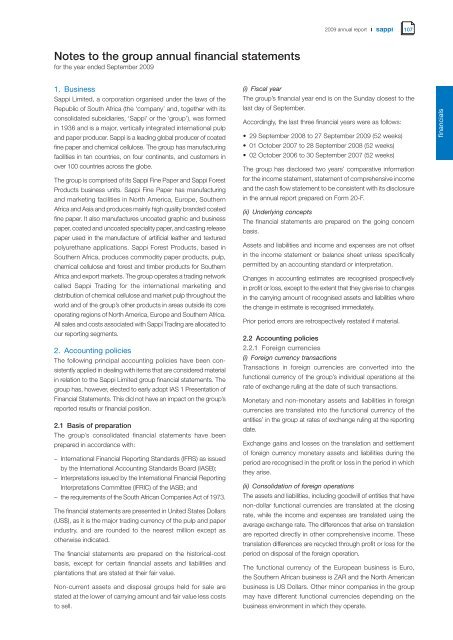Our performance in 2009 - Sappi
Our performance in 2009 - Sappi
Our performance in 2009 - Sappi
Create successful ePaper yourself
Turn your PDF publications into a flip-book with our unique Google optimized e-Paper software.
Notes to the group annual f<strong>in</strong>ancial statements<br />
for the year ended September <strong>2009</strong><br />
1. Bus<strong>in</strong>ess<br />
<strong>Sappi</strong> Limited, a corporation organised under the laws of the<br />
Republic of South Africa (the ‘company’ and, together with its<br />
consolidated subsidiaries, ‘<strong>Sappi</strong>’ or the ‘group’), was formed<br />
<strong>in</strong> 1936 and is a major, vertically <strong>in</strong>tegrated <strong>in</strong>ternational pulp<br />
and paper producer. <strong>Sappi</strong> is a lead<strong>in</strong>g global producer of coated<br />
f<strong>in</strong>e paper and chemical cellulose. The group has manufactur<strong>in</strong>g<br />
facilities <strong>in</strong> ten countries, on four cont<strong>in</strong>ents, and customers <strong>in</strong><br />
over 100 countries across the globe.<br />
The group is comprised of its <strong>Sappi</strong> F<strong>in</strong>e Paper and <strong>Sappi</strong> Forest<br />
Products bus<strong>in</strong>ess units. <strong>Sappi</strong> F<strong>in</strong>e Paper has manufactur<strong>in</strong>g<br />
and market<strong>in</strong>g facilities <strong>in</strong> North America, Europe, Southern<br />
Africa and Asia and produces ma<strong>in</strong>ly high quality branded coated<br />
f<strong>in</strong>e paper. It also manufactures uncoated graphic and bus<strong>in</strong>ess<br />
paper, coated and uncoated speciality paper, and cast<strong>in</strong>g release<br />
paper used <strong>in</strong> the manufacture of artificial leather and textured<br />
polyurethane applications. <strong>Sappi</strong> Forest Products, based <strong>in</strong><br />
Southern Africa, produces commodity paper products, pulp,<br />
chemical cellulose and forest and timber products for Southern<br />
Africa and export markets. The group operates a trad<strong>in</strong>g network<br />
called <strong>Sappi</strong> Trad<strong>in</strong>g for the <strong>in</strong>ternational market<strong>in</strong>g and<br />
distribution of chemical cellulose and market pulp throughout the<br />
world and of the group’s other products <strong>in</strong> areas outside its core<br />
operat<strong>in</strong>g regions of North America, Europe and Southern Africa.<br />
All sales and costs associated with <strong>Sappi</strong> Trad<strong>in</strong>g are allocated to<br />
our report<strong>in</strong>g segments.<br />
2. Account<strong>in</strong>g policies<br />
The follow<strong>in</strong>g pr<strong>in</strong>cipal account<strong>in</strong>g policies have been consistently<br />
applied <strong>in</strong> deal<strong>in</strong>g with items that are considered material<br />
<strong>in</strong> relation to the <strong>Sappi</strong> Limited group f<strong>in</strong>ancial statements. The<br />
group has, however, elected to early adopt IAS 1 Presentation of<br />
F<strong>in</strong>ancial Statements. This did not have an impact on the group’s<br />
reported results or f<strong>in</strong>ancial position.<br />
2.1 Basis of preparation<br />
The group’s consolidated f<strong>in</strong>ancial statements have been<br />
prepared <strong>in</strong> accordance with:<br />
– International F<strong>in</strong>ancial Report<strong>in</strong>g Standards (IFRS) as issued<br />
by the International Account<strong>in</strong>g Standards Board (IASB);<br />
– Interpretations issued by the International F<strong>in</strong>ancial Report<strong>in</strong>g<br />
Interpretations Committee (IFRIC) of the IASB; and<br />
– the requirements of the South African Companies Act of 1973.<br />
The f<strong>in</strong>ancial statements are presented <strong>in</strong> United States Dollars<br />
(US$), as it is the major trad<strong>in</strong>g currency of the pulp and paper<br />
<strong>in</strong>dustry, and are rounded to the nearest million except as<br />
otherwise <strong>in</strong>dicated.<br />
The f<strong>in</strong>ancial statements are prepared on the historical-cost<br />
basis, except for certa<strong>in</strong> f<strong>in</strong>ancial assets and liabilities and<br />
plantations that are stated at their fair value.<br />
Non-current assets and disposal groups held for sale are<br />
stated at the lower of carry<strong>in</strong>g amount and fair value less costs<br />
to sell.<br />
(i) Fiscal year<br />
<strong>2009</strong> annual report<br />
107<br />
The group’s f<strong>in</strong>ancial year end is on the Sunday closest to the<br />
last day of September.<br />
Accord<strong>in</strong>gly, the last three f<strong>in</strong>ancial years were as follows:<br />
• 29 September 2008 to 27 September <strong>2009</strong> (52 weeks)<br />
• 01 October 2007 to 28 September 2008 (52 weeks)<br />
• 02 October 2006 to 30 September 2007 (52 weeks)<br />
The group has disclosed two years’ comparative <strong>in</strong>formation<br />
for the <strong>in</strong>come statement, statement of comprehensive <strong>in</strong>come<br />
and the cash flow statement to be consistent with its disclosure<br />
<strong>in</strong> the annual report prepared on Form 20-F.<br />
(ii) Underly<strong>in</strong>g concepts<br />
The f<strong>in</strong>ancial statements are prepared on the go<strong>in</strong>g concern<br />
basis.<br />
Assets and liabilities and <strong>in</strong>come and expenses are not offset<br />
<strong>in</strong> the <strong>in</strong>come statement or balance sheet unless specifically<br />
permitted by an account<strong>in</strong>g standard or <strong>in</strong>terpretation.<br />
Changes <strong>in</strong> account<strong>in</strong>g estimates are recognised prospectively<br />
<strong>in</strong> profit or loss, except to the extent that they give rise to changes<br />
<strong>in</strong> the carry<strong>in</strong>g amount of recognised assets and liabilities where<br />
the change <strong>in</strong> estimate is recognised immediately.<br />
Prior period errors are retrospectively restated if material.<br />
2.2 Account<strong>in</strong>g policies<br />
2.2.1 Foreign currencies<br />
(i) Foreign currency transactions<br />
Transactions <strong>in</strong> foreign currencies are converted <strong>in</strong>to the<br />
functional currency of the group’s <strong>in</strong>dividual operations at the<br />
rate of exchange rul<strong>in</strong>g at the date of such transactions.<br />
Monetary and non-monetary assets and liabilities <strong>in</strong> foreign<br />
currencies are translated <strong>in</strong>to the functional currency of the<br />
entities’ <strong>in</strong> the group at rates of exchange rul<strong>in</strong>g at the report<strong>in</strong>g<br />
date.<br />
Exchange ga<strong>in</strong>s and losses on the translation and settlement<br />
of foreign currency monetary assets and liabilities dur<strong>in</strong>g the<br />
period are recognised <strong>in</strong> the profit or loss <strong>in</strong> the period <strong>in</strong> which<br />
they arise.<br />
(ii) Consolidation of foreign operations<br />
The assets and liabilities, <strong>in</strong>clud<strong>in</strong>g goodwill of entities that have<br />
non-dollar functional currencies are translated at the clos<strong>in</strong>g<br />
rate, while the <strong>in</strong>come and expenses are translated us<strong>in</strong>g the<br />
average exchange rate. The differences that arise on translation<br />
are reported directly <strong>in</strong> other comprehensive <strong>in</strong>come. These<br />
translation differences are recycled through profit or loss for the<br />
period on disposal of the foreign operation.<br />
The functional currency of the European bus<strong>in</strong>ess is Euro,<br />
the Southern African bus<strong>in</strong>ess is ZAR and the North American<br />
bus<strong>in</strong>ess is US Dollars. Other m<strong>in</strong>or companies <strong>in</strong> the group<br />
may have different functional currencies depend<strong>in</strong>g on the<br />
bus<strong>in</strong>ess environment <strong>in</strong> which they operate.<br />
f<strong>in</strong>ancials
















